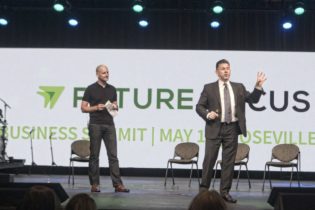A Pathway to the Future of Work

Valley Vision and the Los Rios Center of Excellence recently released Automation Risk for Jobs in the Capital Region, a new research report on the impact of job automation in the nine-county Capital region. This report, supported by the four Capital region Workforce Development Boards, outlines the ways that automation could impact skills, sectors, and people. Additionally, Valley Vision held a webinar on May 15th to share the findings and bring together employers and experts to learn more about how automation is impacting companies here in the region. Ebony Benzing, Research Manager of Los Rios Center of Excellence, reported the key findings of the report:
- Of the 1.2 million jobs in the region, 32% are at high risk of automation, 29% at medium risk of automation, and 39% are at low risk of automation.
- Industries most at-risk of automation in the region are retail trade, accommodations and food services, and construction.
- Of the 50 occupations that employ the most workers in the region, 13 occupations are most at risk of automation, including office clerks, administrative assistants, retail salespersons, accountants, and restaurant cooks.
- The occupations most at risk employ nearly 19.5% of all workers in the region, and pay, on average $12.36 per hour.
- Differing from other regions and the nation as a whole, women in the Capital region are at a higher risk of being impacted by automation due to their higher density in high automation risk occupations, including office administration, retail, and food service.
- Of all ethnic and racial groups, historically minoritized workers are most at-risk of being impacted by automation due to the disproportionate concentration of these workers in high and medium automation risk occupations.
What has been the experience of our webinar panelists with automation and COVID-19?
- The hospitality and tourism sector has been significantly impacted by COVID-19 and, compared to other sectors in the region, is at the highest risk of automation of jobs and skills. Mike Testa, President and CEO of Visit Sacramento, noted that the global pandemic has created significant challenges for the industry, and that new ways of doing business have emerged and may remain with us. One example that he shared was that, as work goes mobile and jobs are impacted, some functions might become less relevant, like administrative support and others, much like the data reflects.
- David Banuelos Jr., Partnership Coordinator (CA Region 1), U.S. Census Bureau, noted that now is the time to find opportunities for retraining. He is seeing a disproportionate impact in layoffs to low income and minority populations and notes that it will be critically important to address the needs of these populations with support and retraining opportunities.
- While the research suggests that manufacturing sector is at high risk of automation, Kevin McGrew, Director of Quality Management at Siemens and President of the Sacramento Valley Manufacturing Initiative, indicated manufacturing is not experiencing the severity of layoffs in this region that other sectors are seeing. Rather, manufacturing has been more impacted by repurposing operations to support production of Personal Protective Equipment (PPE).

What meaning can we make of the report findings?
Automation and other technology trends already in motion will only gain momentum as the global pandemic reshapes our economy and ways of doing work. Most people are experiencing significant changes to their traditional methods of work, layoffs are rampant, and many face an uncertain future. California has received 4.5 million unemployment insurance claims and anticipates an unemployment rate greater than 20% by the end of May. As these economic impacts settle in and we build towards recovery in the future, technology trends show we might not ever return to “normal” as we knew it just a few months ago. Those in low wage, high automation risk jobs are now and will remain most vulnerable to changes in our economy and the way work is done.
How do we address these challenge?
It is critically important that we work on building system resiliency in our workforce, education, and employment systems now and take concrete steps to provide appropriate training and skill-building opportunities. Valley Vision is working to advance digital skill building and digital literacy as a critical equity strategy to promote social mobility and future job readiness. Valley Vision has championed digital skill building as a regional strategy through the Prosperity Strategy work, and has led multiple digital skill projects for the last several years. We helped establish the Sacramento Coalition for Digital Inclusion, and with support from Union Bank, are focusing on Code, Digital Media Creation and Digital Literacy for 7,500 students in high-need communities where census tracts indicate broadband adoption is less than 82% in Sacramento (California’s state-wide adoption average). We are also creating broadband access during this critical time. As the manager of the Connected Capital Area Broadband Consortium (CCABC), Valley Vision coordinates efforts to fill critical broadband infrastructure gaps and improve access in homes, schools, and businesses. This work places us at the center of strategic efforts to improve broadband access in California’s Capital Region, paving the way for future-ready infrastructure and regional prosperity. These projects are critical to closing digital skills gaps and are a key piece of the Sacramento Region’s Future of Work strategy.
As a region in the midst of rapid economic and social transformation, the challenges ahead include risks and opportunities. We need to remain encouraged, focused on navigating the needs of today while anticipating changes to come, and maintain a sense of optimism that we can create a bright, inclusive future for all. Stay tuned as Valley Vision continues advancing solutions, preparing us for a resilient and prosperous future.
Evan Schmidt is Valley Vision’s Senior Director working on the Public Opinion Surveying initiative and projects in the Healthy Communities and 21st Century Workforce impact areas.




